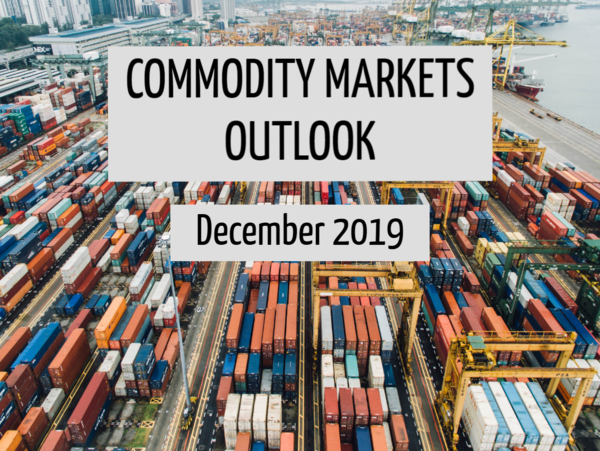
Global Macro: 2019 has been a strong year in commodities, amid volatile returns, and recovered the loss made in 2018. The heightened level of uncertainty combined with a high level of other risky assets has given some strong interest from investors to look back into precious metals. Gold is up nearly 16% on the year, buoyed by geopolitical risks in the Middle East and political uncertainty in the US. An accommodative Fed stance with a lack of inflation prospect has been raising interest for cheaper, on a relative basis, real assets compared to highly valued markets. Central banks, also being accommodative, are concerned about the potential leeway they can use in case of a market downturn. PBOC is adopting a ‘just necessary’ approach with targeted actions aiming for a ‘well managed’ necessary slow down. This is reflected in economic activity indicators and an expected YoY GDP growth to be below 6% in 2020.
Metals: Base metals complex performed poorly in 2019 and also in December, reflecting an end of cycle situation where manufacturing is slowing to level where demand for the complex is slowing with marginal capacity of miners and sufficient inventory. Our equally weighted base metal complex is flat on the year with nickel (+30% in 2019) experiencing huge volatility swings.
Energy: The fundamentals do not justify the upside potential in the petroleum complex. The lower global inventory levels (near the 5 years average) is making the market reaction to geopolitical even more extreme and is increasing volatility in the sector. Supply disruptions in December have fuelled investor bullishness with crude up nearly 10% in the month (up 30% on the year). With an increasing carry due to the backwardation in the curves, the market is likely to suffer sharp reversals as the market becomes overbought. A backwarded curve reduces capital expenditure in the sector and potentially could reduce marginal capacity which is still at this stage sufficient for OPEC and non-OPEC, and very little expenditure is expected to increase shale production. OPEC compliance to their quota has also supported the market but if expected disruption does not occur in the next few months (Iranian retaliation targeting oil assets), the level of oil should remain.
Agriculture: Grain markets improved in December due to adverse weather conditions raising the risk of crop damage for wheat (winter Kansas wheat +8% in December, -14% in 2019). On softs, tightening supply on Arabica coffee moved the price higher (+9% in December) as Brazilian crop is expected to be weaker and demand has pushed inventory level lower.
Volatility: Except for the energy sector, there was generally a slight increase of volatility in December, despite all underlyings showing strong gains. This is likely reflecting rising concerns over potentially overbought assets. In the equity sector, the VIX is up on the month from 12.62% to 13.78% while the VSTOXX is up from 13.17% to 13.95%. We saw an increase of volatility in the agricultural sector as well, with implied volatility for ATM calls up from 14% to 17% for corn and from 11% to 14% for soybean. In precious metals, gold implied volatility stagnated at 10% but for silver it rose from 16% to 18%. In contrast, crude implied volatility dropped from 30% to 23% on the month and even touched 18%, its yearly low last seen in April, with underlying crude price continuing to improve steadily.
Source: Four Elements Capital
